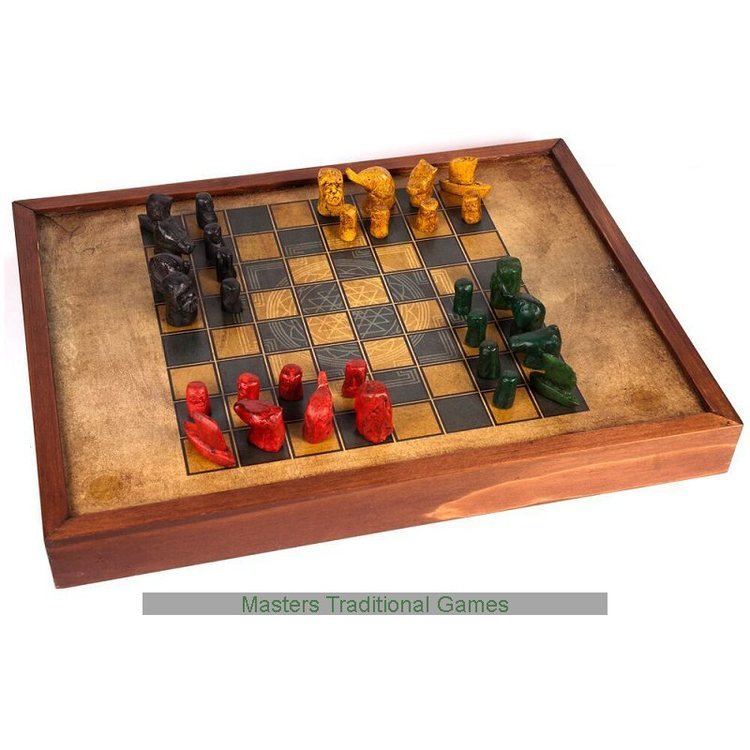 | ||
Chaturanga
Chaturanga (Sanskrit: चतुरङ्ग; caturaṅga), or catur for short, is an ancient Indian strategy game which is the common ancestor of the board games: chess, shogi, sittuyin, makruk, xiangqi and janggi.
Contents
Chaturanga developed in the Gupta Empire, India around the 6th century AD. In the 7th century, it was adopted as shatranj in Sassanid Persia, which in turn was the form of chess brought to late-medieval Europe.
The exact rules of chaturanga are unknown. Chess historians suppose that the game had similar rules to those of its successor shatranj. In particular, there is uncertainty as to the moves of the Gaja (elephant), the precursor of the modern chess bishop.
Chaturanga preview
History
Sanskrit caturaṅga is a bahuvrihi compound, meaning "having four limbs or parts" and in epic poetry often meaning "army". The name comes from a battle formation mentioned in the Indian epic Mahabharata, referring to four divisions of an army, namely elephants, chariots, cavalry and infantry. An ancient battle formation, akshauhini, is like the setup of chaturanga.
Chaturanga was played on an 8×8 uncheckered board, called ashtāpada, which is also the name of a game. The board sometimes had special markings, the meaning of which are unknown today. These marks were not related to chaturanga, but were drawn on the board only by tradition. Chess historian H. J. R. Murray conjectured that the ashtāpada was also used for some old race-type dice game, perhaps similar to chowka bhara, in which the marks had meaning.
An early reference to an ancient Indian board game is sometimes attributed to Subandhu in his Vasavadatta (c. AD 450):
The time of the rains played its game with frogs for pieces [nayadyutair] yellow and green in colour, as if mottled by lac, leapt up on the black field squares.
The colours are not those of the two camps, but mean that the frogs have two colours, yellow and green.
Banabhatta's Harsha Charitha (c. AD 625) contains the earliest reference to the name chaturanga:
Under this monarch, only the bees quarrelled to collect the dew; the only feet cut off were those of measurements, and only from Ashtâpada one could learn how to draw up a chaturanga, there was no cutting-off of the four limbs of condemned criminals...
While there is little doubt that ashtâpada is the gameboard of 8×8 squares, the double meaning of chaturanga, as the four-folded army, may be controversial. There is a probability that the ancestor of chess was mentioned there.
The game was first introduced to the West in Thomas Hyde's De ludis orientalibus libri duo, published in 1694. Subsequently, translations of Sanskrit accounts of the game were published by Sir William Jones.
In Arabic, most of the terminology of chess is derived directly from chaturanga: Modern chess itself is called chitranj in Arabic, and the bishop is called the elephant.
Rules
The initial position is as shown. White moves first. The objective in chaturanga, the same as modern chess, is to checkmate the opponent's Raja (king).
Pieces and their moves
- Two squares in any diagonal direction, jumping over the first square, as the alfil in shatranj. This is a fairy chess piece which is a (2,2)-leaper.
- The same move is used for the boat in chaturaji, a four-player version of chaturangam.
- The elephant in xiangqi has the same move, but without jumping.
- One step forward or one step in any diagonal direction.
- The same move is used for the khon (nobleman) in makruk (Thai chess) and the sin (elephant) in sittuyin (Burmese chess), as well as for the silver general in shogi.
- The move was described c. 1030 by Biruni in his book India.
- Two squares in any orthogonal (vertical or horizontal) direction, jumping over the first square.
- A piece with such a move is called a dabbābah in some chess variants. The move was described by the Arabic chess master al-Adli c. 840 in his (partly lost) chess work. (The Arabic word dabbābah in former times meant a covered siege engine for attacking walled fortifications; today it means "army tank".)
- The German historian Johannes Kohtz (1843–1918) suggests, rather, that this was the earliest move of the Ratha.
Additional rules
Al-Adli mentions two further differences:
